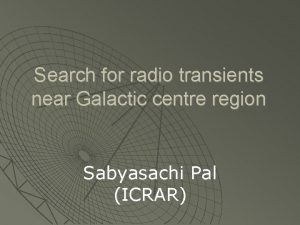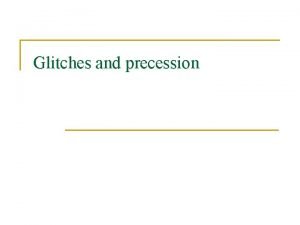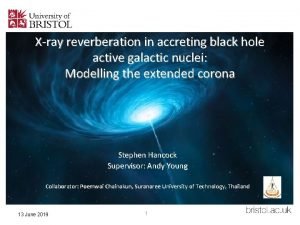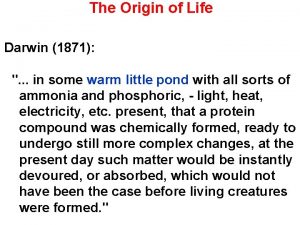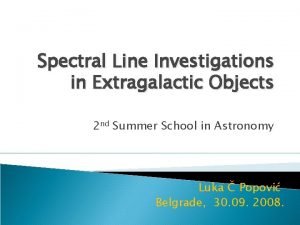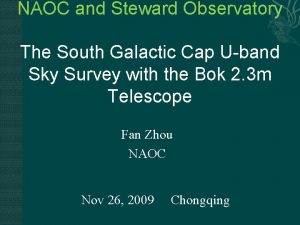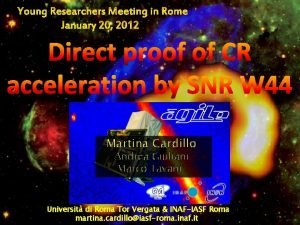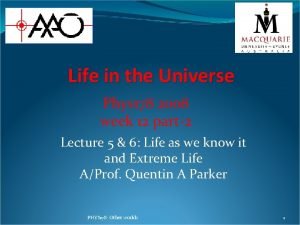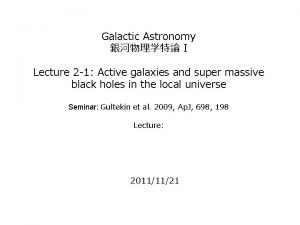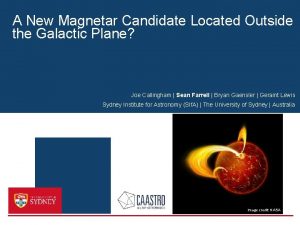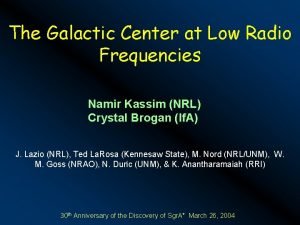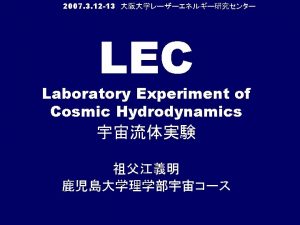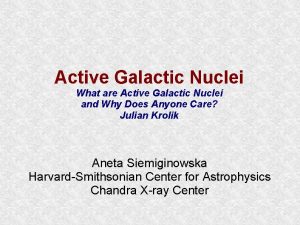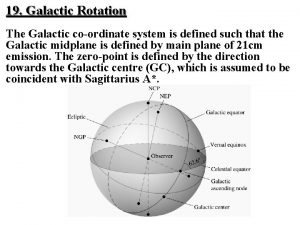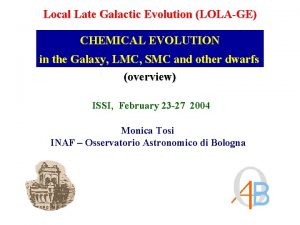The Radio Evolution of the Galactic Center Magnetar















- Slides: 15

The Radio Evolution of the Galactic Center Magnetar Joseph Gelfand (NYUAD / CCPP) Scott Ransom (NRAO), Chryssa Kouveliotou (GWU), Mallory S. E. Roberts (NYUAD), Hind Al Ali (NYUAD), Yoni Granot 2015 December 17 28 th Texas Symposium on Relativistic Astrophysics 1

Outline n What is a magnetar? n n Galactic Center Magnetar SGR J 1745‒ 29 n n Why care about a magnetar’s radio emission? Located only a few parsecs from Sgr A* New observations n n 44 GHz pulsations: Predominantly bright single pulses Broadband continuum radio: Possible change in radio spectrum 2015 December 17 28 th Texas Symposium on Relativistic Astrophysics 2

What is a magnetar? n Class of isolated neutron star n n n ≥ 1014 G external magnetic fields Even stronger internal magnetic fields Emission powered by magnetic field decay 2015 December 17 (Illustration: NASA/CXC/M. Weiss) 28 th Texas Symposium on Relativistic Astrophysics 3

Why do we think “magnetars” exist? n Neutron stars with high Ṗ, P n n Soft Gamma Repeaters (SGRs) n n n Dipole Surface B ≥ few× 1013 G Repeated bursts of hard X-rays Giant flares Anomalous X-ray Pulsars n n (Palmer et al. 2005, Nature, 434, 1107) Blackbody X-ray spectrum Lx ≥ Ė (Younes et al. 2015, ar. Xiv: 1507. 05985) 2015 December 17 28 th Texas Symposium on Relativistic Astrophysics 4

Magnetar “activation” n Rapid increase in X-ray luminosity n n n ≥ 1000 x quiescent luminosity Followed by slow exponential decay to new steady-state level Magnetar often produces pulsed radio emisson et Ap. J, al. 2006, (Ibrahim et(Camilo al. 2004, 609, Nature, L 21) 442, 892) 2015 December 17 28 th Texas Symposium on Relativistic Astrophysics 5

Pulsed radio emission from a magnetar n Radio Pulsars n n n Stable pulsar shape Constant flux density Steep radio spectrum Somewhat polarized Bright single pulses rare 2015 December 17 Magnetars n Variable pulse shape Variable flux density Flat or gigahertz radio spectrum ~100% linear polarization Bright single pulses common Different emission mechanism? n n 28 th Texas Symposium on Relativistic Astrophysics 6

Galactic Center Magnetar J 1745 -29 n SGR 2013 Apr 24: Swift XRT detects increase in X-rays from GC region n n 2013 Apr 26: Nu. STAR detects 3. 76 s pulsations Subsequent decrease in X-ray (Mori et al. 2013, Ap. J, 770, L 23) flux (Credit: NASA/CXC/INAF/F. Coti Zelati et al) (Kaspi et al. 2014, Ap. J, 786, 84) 2015 December 17 28 th Texas Symposium on Relativistic Astrophysics 7

Early Radio Observations n n 2013 May 1 2013 May 31 Radio spectral variability Particularly ≤ 10 GHz Flattening of spectrum Constant flux density n (Pennucci et al. 2015, Ap. J, 808, 81) (Lynch et al. 2015, Ap. J , 806, 266) Until 2014 Mar 2015 December 17 (Shannon and Johnston 2013, MNRAS, 435, L 29) 28 th Texas Symposium on Relativistic Astrophysics 8

44 GHz GBT Observation n 2014 April 10 (MJD 53105) n n n 35 minutes: GUPPI 30 minutes: VEGAS Clear detection n n Bright single pulses from ~70% of rotations Narrow phase distribution 2015 December 17 (Gelfand et al. , in prep. ) 28 th Texas Symposium on Relativistic Astrophysics 9

Flux distribution of single pulses n Log-normal distribution n n 8. 5 GHz (Lynch et al. 2015, Ap. J, 806, 266) Similar distribution as 8. 5 GHz Possible explanations n n Same physical generating mechanism Constant across observations? (Yan et al. 2015, Ap. J, 814, 5) (Gelfand et al. , in prep. ) 2015 December 17 28 th Texas Symposium on Relativistic Astrophysics 10

Broadband radio spectrum n JVLA Project Code TOBS 0006 n n n In expectation of G 2 encounter with Sgr A* 1. 5 – 41 GHz in 8 bands A configuration: 2014 Feb 15 – 2014 May 31 2015 December 17 28 th Texas Symposium on Relativistic Astrophysics 11

GC Magnetar Flux Density n Very crowded region n n Significantly contaminates magnetar flux Magnetar u, v filtering n n 2013 -10 -26 Bconfiguration 2014 -05 -31 Aconfiguration Removes diffuse emission Give consistent results (Gelfand et al. , in prep. ) (http: //www. astro. ucla. edu/~ghezgroup/gc/journey/dynamic. Gas. shtml) 2015 December 17 28 th Texas Symposium on Relativistic Astrophysics 12

Continuum radio spectrum n n Not Giga-hertz peaked a = -1. 36 ± 0. 05 Power law n n nb = 3. 7 ± 1. 2 GHz a = -0. 42 ± 0. 06 Very good fit for first two epochs Broken power law n a = -1. 16± 0. 41 a = -0. 18 ± 0. 09 anb== -0. 25 ± 0. 07 5. 5 ± 0. 3 GHz Works better for last two epochs a = -0. 56 ± 0. 09 (Pennucci et al. 2015, Ap. J, 808, 81) (Gelfand et al. , in prep. ) 2015 December 17 28 th Texas Symposium on Relativistic Astrophysics 13

POSSIBLE interpretation n Flux increase at low frequencies n n 2014 July - August New emission component? If so, likely has a steep spectrum (Re-) appearance of “normal” radio pulsar emission? Possibly seen at later epochs (Torne et al. 2015, MNRAS, 451, L 50) 2015 December 17 28 th Texas Symposium on Relativistic Astrophysics 14

Summary n 44 GHz Pulsed Emission n n ~70% of rotations produce a bright radio pulses Log-Normal Flux distribution Same parameters as composite 8. 5 GHz observations Thank you! 1. 4 – 44 GHz Radio Continuum Emission n First two epochs single power-law Later two epochs broken power-law (? ) Increase in low-frequency flux → “normal” pulsar emission mechanism? 2015 December 17 28 th Texas Symposium on Relativistic Astrophysics 15
 Galactic centre radio transients
Galactic centre radio transients Magnetar
Magnetar Trunking vs conventional radio system
Trunking vs conventional radio system Galactic address
Galactic address City model
City model Star wars combine
Star wars combine Burgess concentric zone model
Burgess concentric zone model Peripheral model
Peripheral model Reverberation
Reverberation Galactic habitable zone
Galactic habitable zone Active galactic nuclei
Active galactic nuclei Galactic phonics ure
Galactic phonics ure Galactic cap review
Galactic cap review Galactic plane
Galactic plane Galactic habitable zone
Galactic habitable zone Active galactic nuclei
Active galactic nuclei
